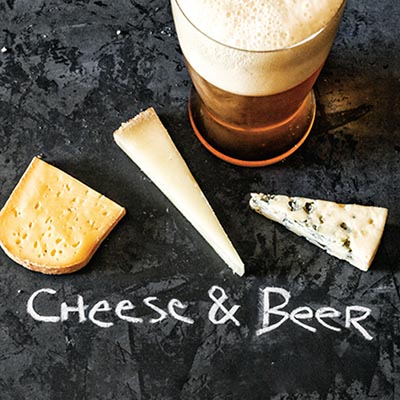Brad Sinko has already earned his place in the cheesemakers’ hall of fame with his creation of Flagship, Flagship Reserve and Flagsheep. These Cheddar-style wheels, which he developed for Beecher’s Handmade Cheese in Seattle, have won heaps of critical acclaim and awards, including American Cheese Society Best of Show for Flagsheep.
But after a decade with Beecher’s, Sinko has returned to his roots. Two years ago, he relocated to coastal Southern Oregon, to help establish a new creamery on the site of the former Bandon Cheese Factory. The sweet part of the story is that Sinko’s father once owned the factory; after his dad sold it to Tillamook, Sinko stayed on to run the creamery for three years. But when he left for Beecher’s, Tillamook tore the plant down, leaving an eyesore at the heart of this seaside community.
Now two developers, in partnership with the town, have brought cheesemaking back to Bandon. The new Face Rock Creamery produces primarily cheese curds, block Cheddar and flavored Cheddars, although Sinko is making a traditional clothbound Cheddar as well. He is sourcing all his milk from a single farm less than 15 miles away.
I recently sampled all but the flavored Cheddars—not my thing—and can affirm that Sinko hasn’t lost his touch. The year-old block Cheddar was tasty, but the two-year-old Premium Extra Aged was the one I kept coming back to.
These are rindless Cheddars, made in 40-pound blocks and aged in bags without exposure to air. With age, they become creamier, I find. Rinded cheeses, which lose moisture as they mature, tend to get more brittle and waxy-textured over time. The Face Rock Extra Aged has a butter-colored paste with aromas of freshly mown grass and nuts. Shaved with a cheese plane, it yields silky sheets; cut into chunks, it seems more buttery and creamy. I like it both ways.
As he did at Beecher’s, Sinko is using a mix of cultures—some traditional for Cheddar, some not—to create a cheese with more mellow flavor and less bite. The Extra Aged has the acidity you expect from Cheddar but no sharpness. On the creamery’s web site, the cheese retails for $16 a pound, a good value even with some shipping expense.
I asked Sinko if he had put some blocks away for additional aging; this is the kind of Cheddar that only gets better with another year or three of controlled storage. “We’ll have lots of that available later,” he assured me. “We just have to get older.”
Enjoy Face Rock’s Premium Extra Aged Cheddar with a pale ale, brown ale or ESB, or with a Merlot. Currently it is available only via Face Rock’s online store or at the creamery. The year-old Cheddar is more widely available. In Northern California, look for it at Costco; in Southern California, at Haggen stores. In the Pacific Northwest, it’s available in several chains: Costco, Fred Meyer, Safeway/Albertsons, Haggen and Thriftway; in Colorado at King Soopers; and in Utah at Smith’s. The clothbound Cheddar is at Market of Choice and New Seasons Markets in Oregon.
Acclaimed Beer Writer at August Cheese Class
I’m thrilled to announce that Jay Brooks, publisher of the Brookston Beer Bulletin, will join us for “Artisan Cheese & Craft Beer: Seven Perfect Pairings,” on Monday, August 3. I’m a craft-beer enthusiast, but Jay, a leading beer journalist, really knows the beat. He’ll provide the color commentary to help us understand the beers, and I’ll be eager to know what he thinks of my cheese choices. Just a few seats remain for this guided tasting, in which I hope to convince you that beer and cheese—delicious alone—are even better together. Reserve here.



